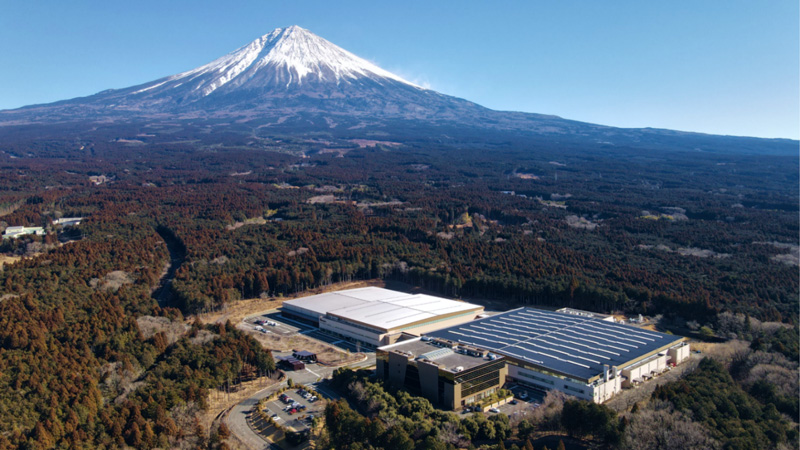Biodiversity
Basic policy
The AMADA Group has been carrying out initiatives for the conservation and regeneration of biodiversity as part of its Environmental Policy since 2010. Biodiversity conservation depends on understanding the status of ecosystems in each region. Since 2015, the AMADA Group has been surveying the biodiversity of each of its business sites in Japan employing the land use assessment tool provided by the Japan Business Initiative for Biodiversity (JBIB), and has been implementing initiatives tailored to each site.
Green Infrastructure initiatives
The AMADA Group is engaged in the Green Infrastructure initiative as defined and supported by Japan’s Ministry of Land, Infrastructure, Transport and Tourism. Green infrastructure refers to efforts to promote sustainable and attractive national, urban, and regional development by utilizing the diverse functions of the natural environment.
In November 2021, we installed green infrastructure to the garden exterior on the south side of AMADA FORUM at the Isehara Works. We reopened the garden as a “rain garden” equipped with a rainwater harvesting function. This permeable green space collects and cleans rainwater before gently allowing it to seep into the soil. In addition to mitigating the load on drainage pipes during heavy rains, preventing the flooding of sidewalks and driveways, and improving water quality, it also offers beautiful scenery as a garden made with white gravel, masonry, and plants.
In spring 2022, we also added a rain garden on the west side of the Third Plant at the Fujinomiya Works West Block. During heavy rainfall, the rain garden is effective in controlling rainwater runoff, purifying water quality, and funneling it into the soil. At other times, it serves as a biodiversity-friendly green space for grassland ecosystems.

- Fujinomiya Works rain garden awarded the Excellence Award at the 3rd Green Infrastructure Awards
- The Rain Garden initiative at the Fujinomiya Works received an Excellence Award in the Disaster Prevention and Mitigation category at the 3rd Green Infrastructure Awards organized by the Green Infrastructure Public-Private Partnership Platform, which is comprised of the national government, private companies, academic groups, and other organizations. This award was selected by a screening vote of platform members (approximately 1,600 companies and organizations).

Local initiatives for preserving biodiversity
Fujinomiya Works
The AMADA Group works to preserve biodiversity through its “AMADA Forest Creation program.”
Approximately 60% or around 430,000 ㎡ of the Fujinomiya Works premises is forested land. On these premises, we have confirmed the presence of around 1,100 species of plants and animals. When the forest in front of the Second Factory was reforested, we found trees such as konara oak and Japanese snowbell, as well as Japanese lady’s slipper orchid, a kind of orchid listed as a Category II (Vulnerable/VU) endangered species by the Ministry of the Environment and Shizuoka Prefecture.
Approximately 80% of these forests are artificially planted Japanese cypress. Since it has been more than 50 years since the trees were planted, we are planning to proactively improve the forest into one rich with plants and wildlife.

Wildlife identified at the Fujinomiya Works (partial)

Calanthe discolor - Orchid 
Japanese weasel 
Indolestes peregrinus - Dragonfly 
Cyanoptila cyanomelana (juvenile) - Flycatcher
Isehara Works
The rooftop garden near the Isehara Works main building was created about 45 years ago. What started out as a handful of trees are now several dozen. A variety of birds can be seen in the garden. Among these birds are the Japanese tit (Parus minor), which can be observed in the nesting boxes.
The vegetation has been designed to ensure a balance of trees, primarily those favored by wild birds and butterflies, and allow visitors to enjoy flowers blooming in all four seasons.

Toki Works
The biotope at the Toki Works was designed to facilitate the effective use of on-site spring water, and also as a small reservoir for irrigating plants. It covers an area of 200 ㎡ and holds approximately 100 tons of water. The pond is heart-shaped when viewed from above. Local granite known as “mino kurama” is used around the edges of the pond.
Water, greenery, and stones come together in harmony at the biotope, which also serves as an oasis for employees. Even foxes make occasional visits here.


Ono Plant
At the Ono Plant (Ono City, Hyogo Prefecture), Ono City’s Roads and River Division provided us with fragrant eupatorium, a plant species endemic to Kakogawa River, at the end of March 2022, and we transplanted it to our plant premises for cultivation. The fragrant eupatorium that sprouted in March 2023 were donated to the same division of the city.

